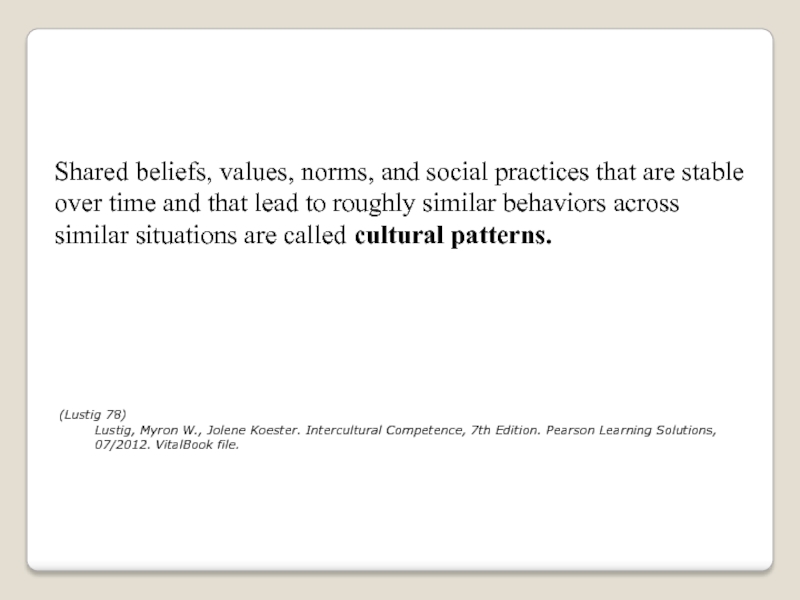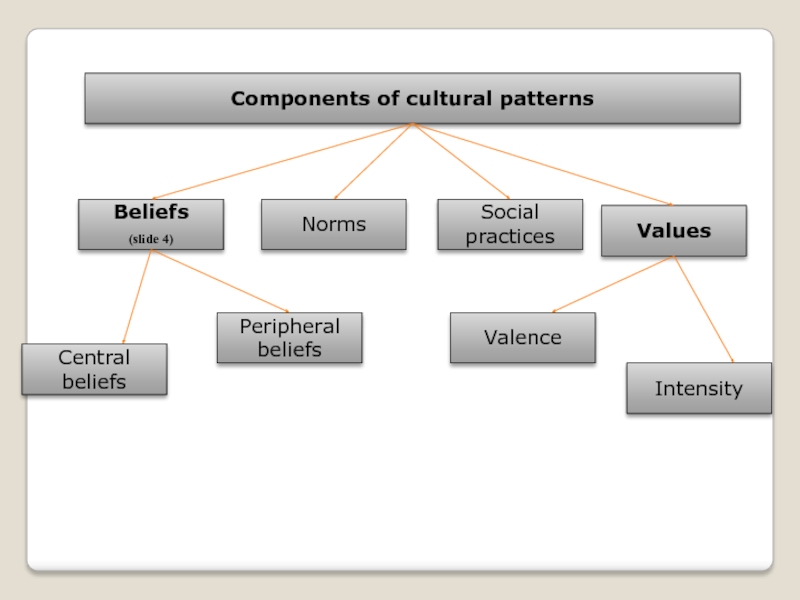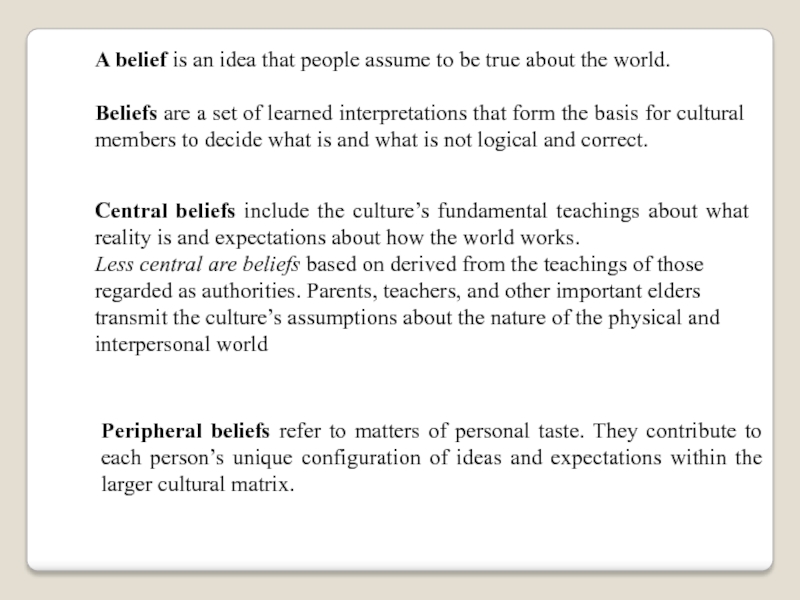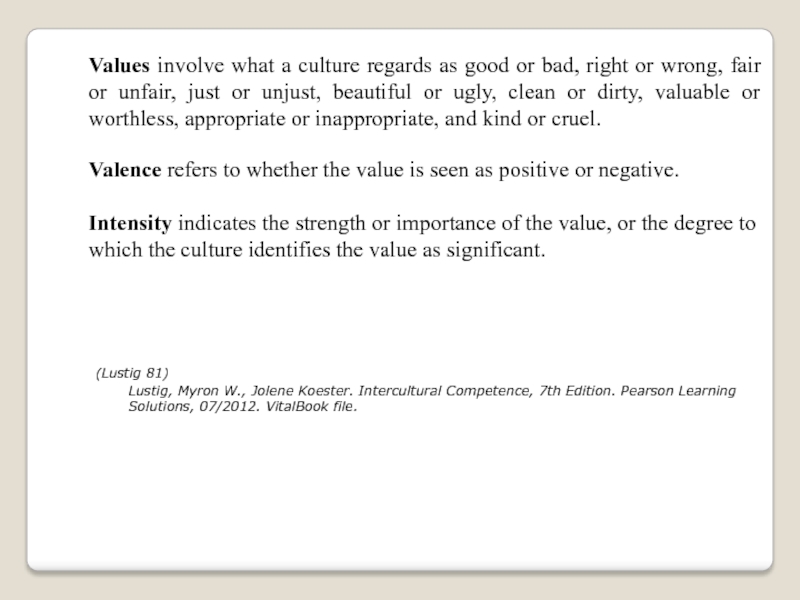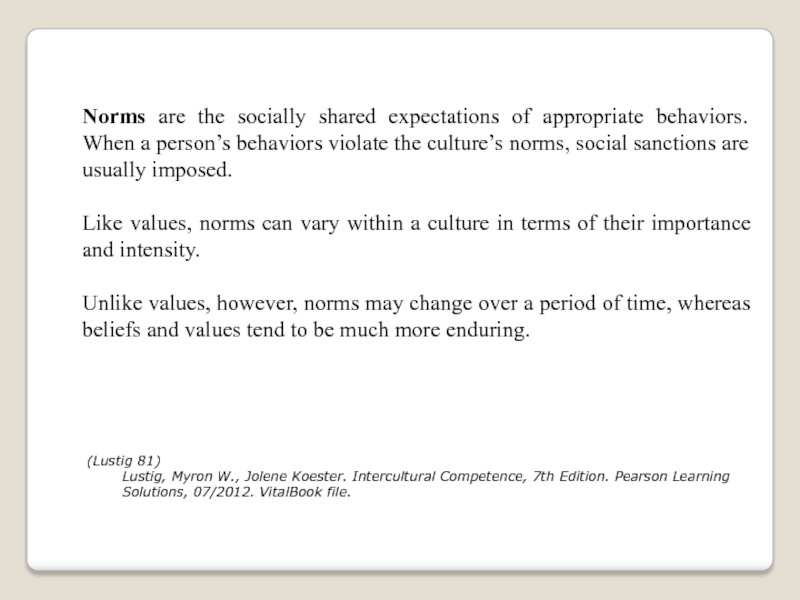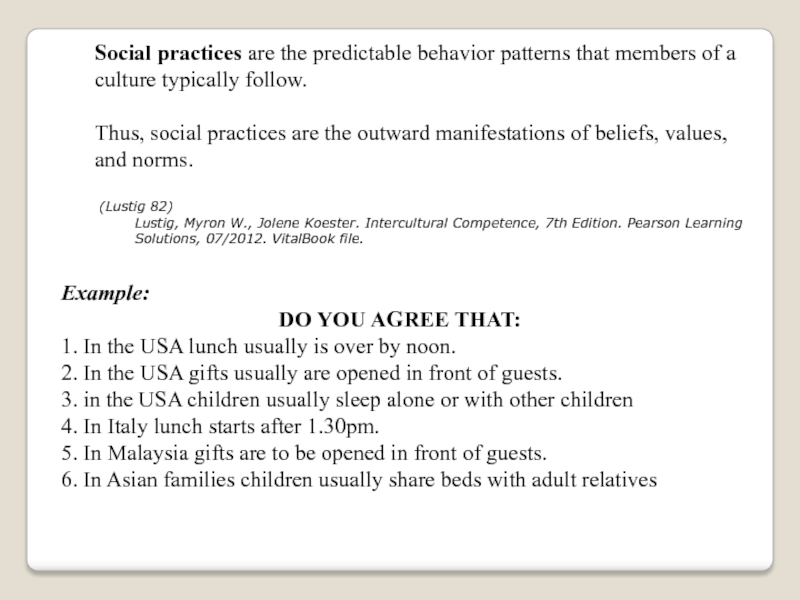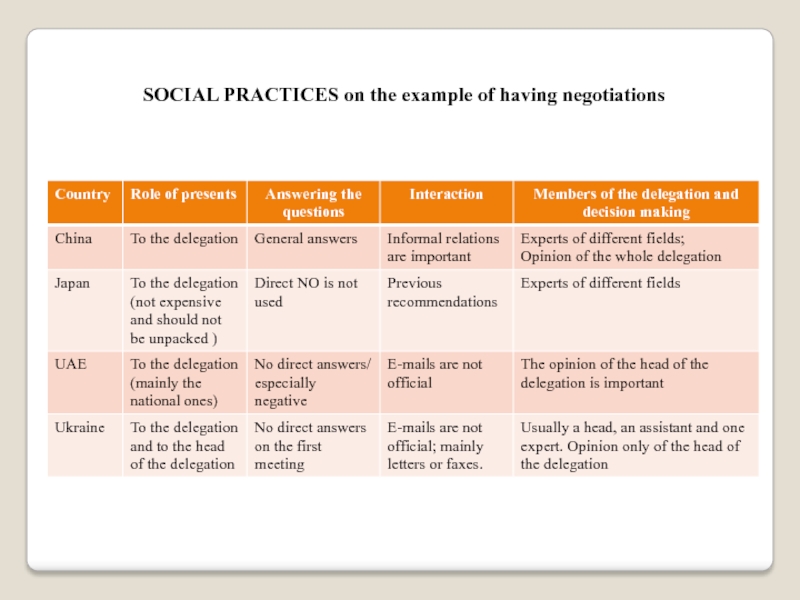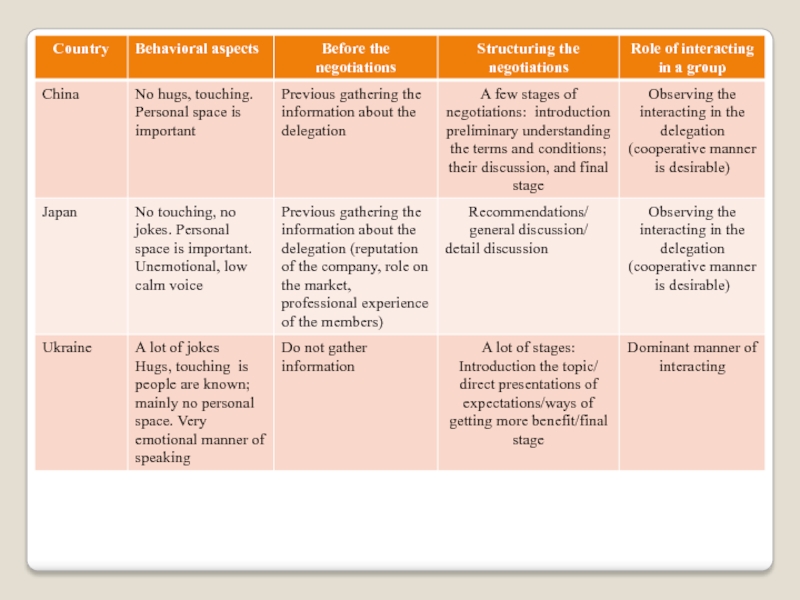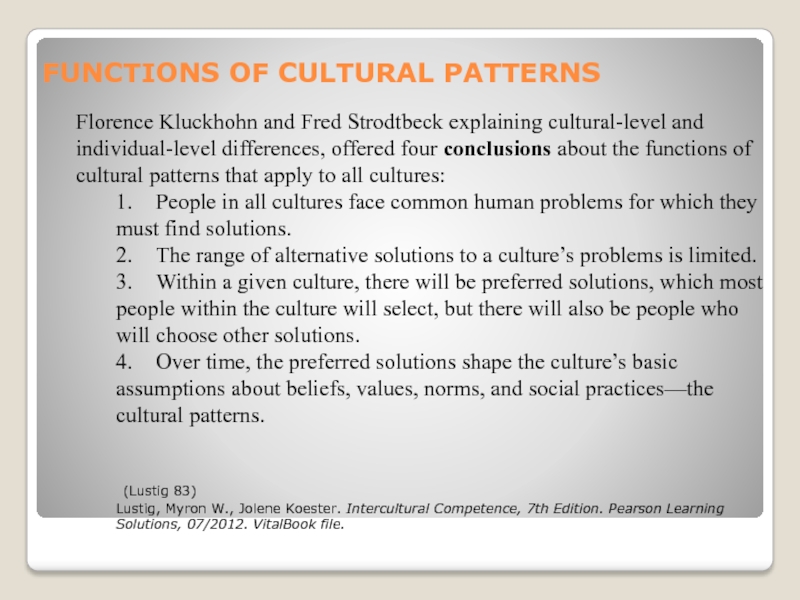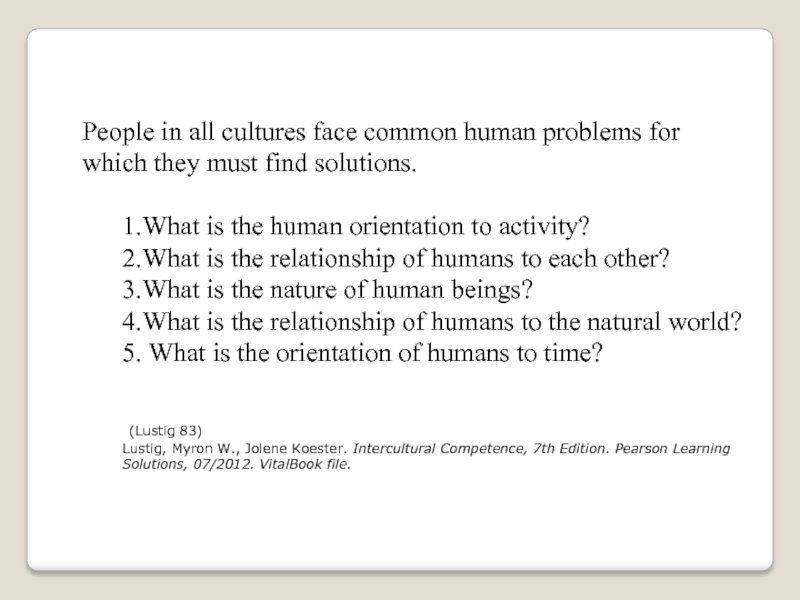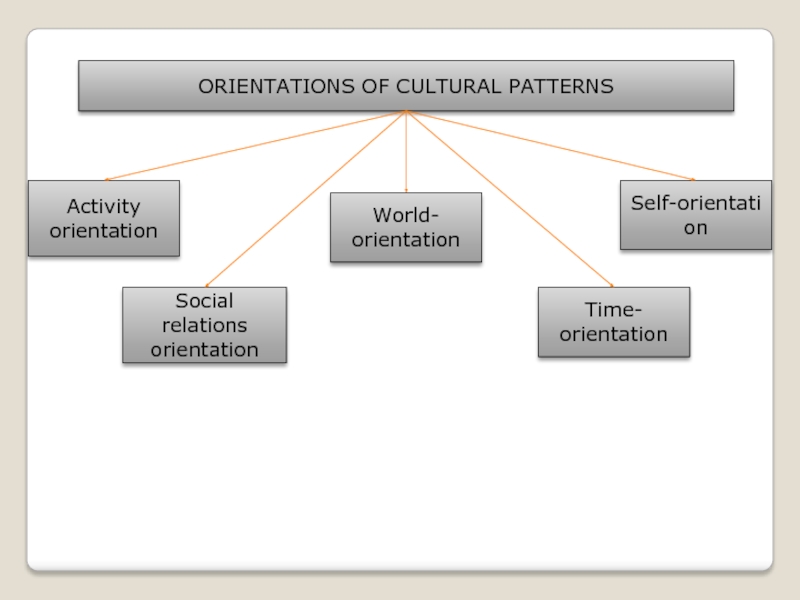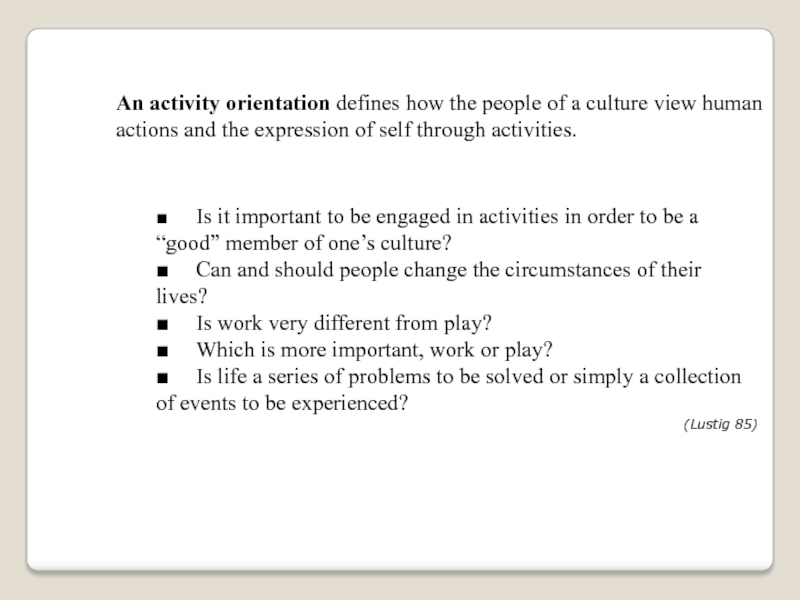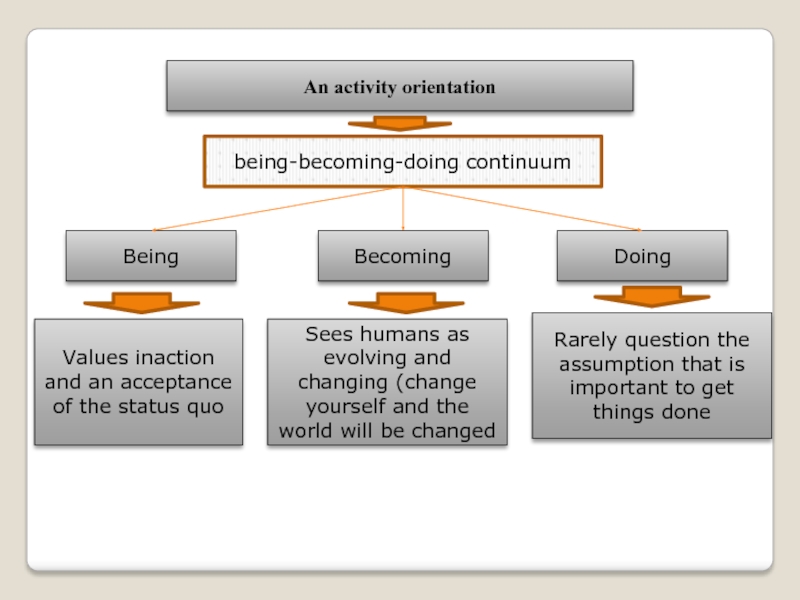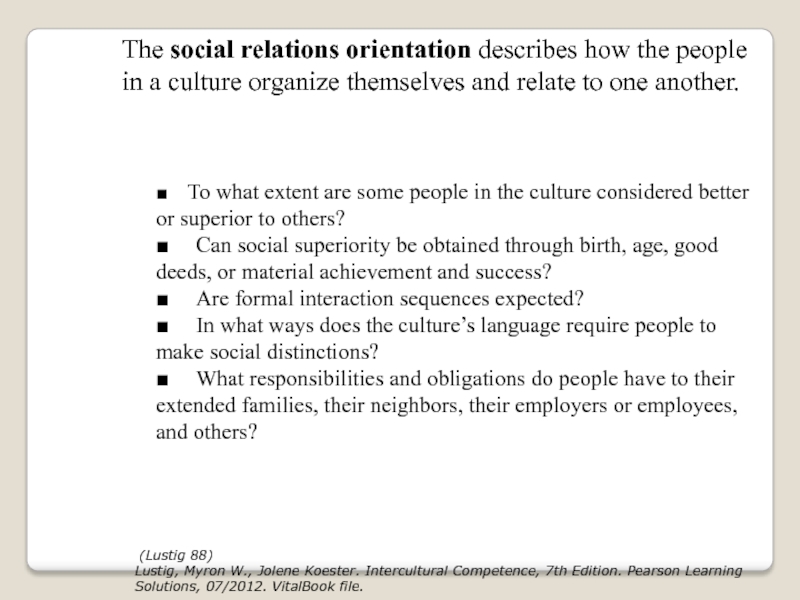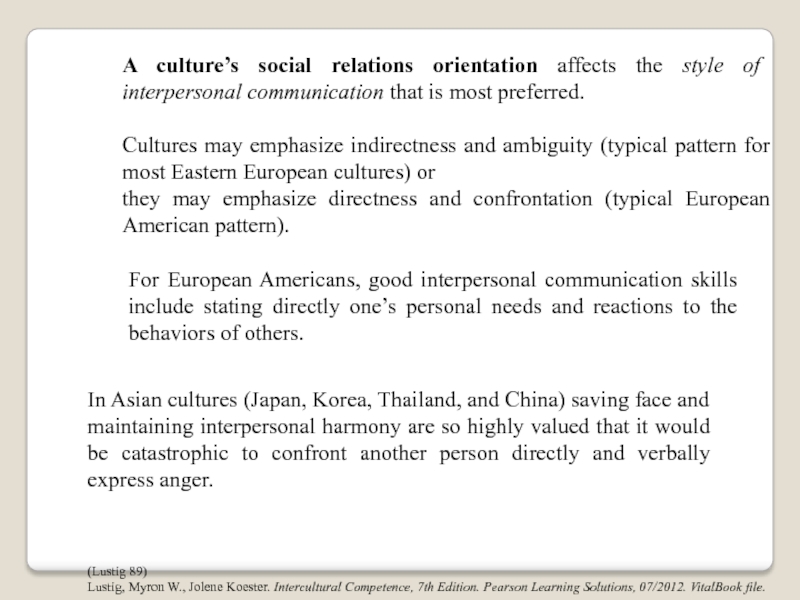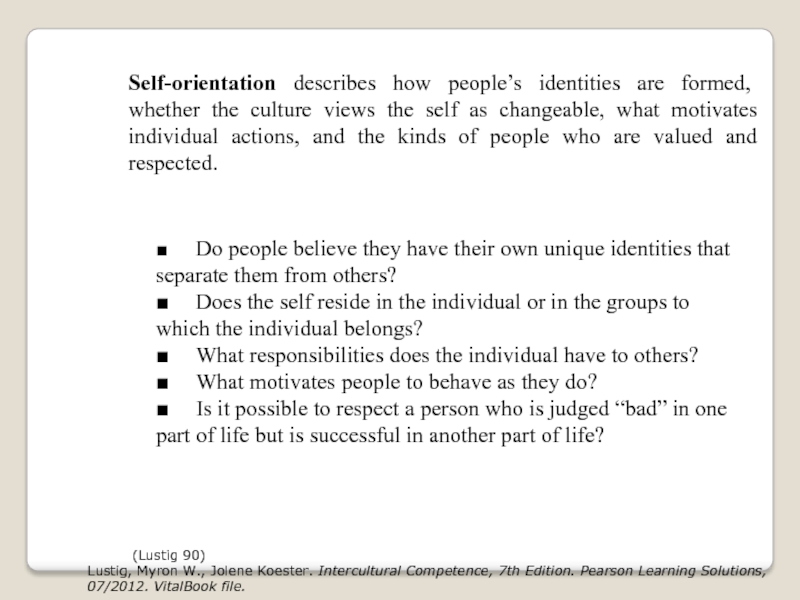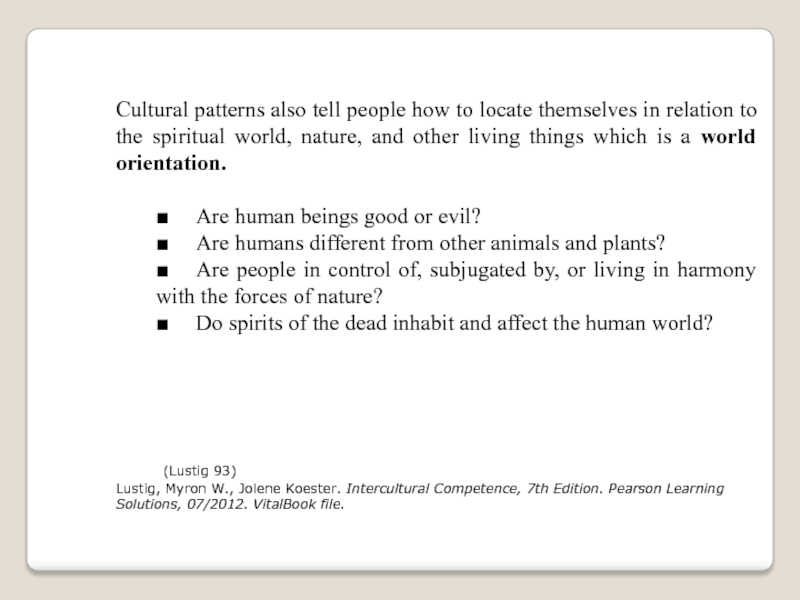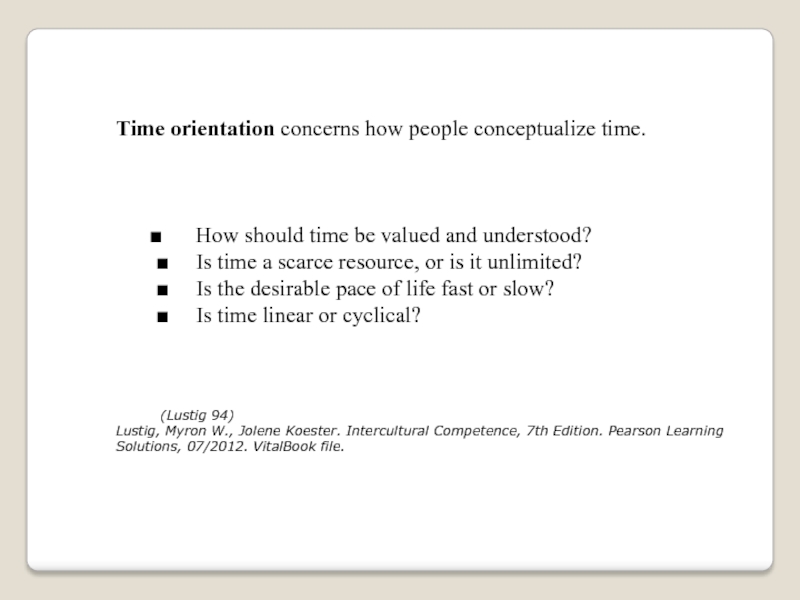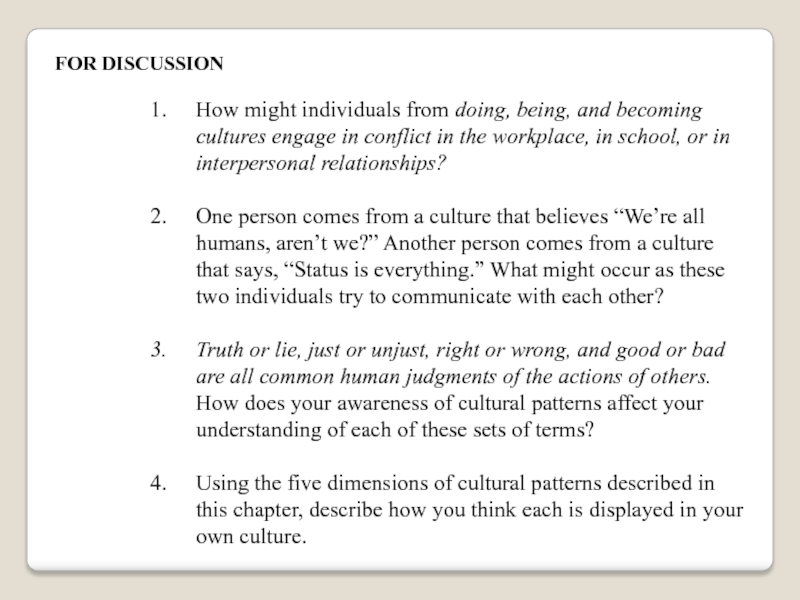- Главная
- Разное
- Дизайн
- Бизнес и предпринимательство
- Аналитика
- Образование
- Развлечения
- Красота и здоровье
- Финансы
- Государство
- Путешествия
- Спорт
- Недвижимость
- Армия
- Графика
- Культурология
- Еда и кулинария
- Лингвистика
- Английский язык
- Астрономия
- Алгебра
- Биология
- География
- Детские презентации
- Информатика
- История
- Литература
- Маркетинг
- Математика
- Медицина
- Менеджмент
- Музыка
- МХК
- Немецкий язык
- ОБЖ
- Обществознание
- Окружающий мир
- Педагогика
- Русский язык
- Технология
- Физика
- Философия
- Химия
- Шаблоны, картинки для презентаций
- Экология
- Экономика
- Юриспруденция
Intercultural aspects of management презентация
Содержание
- 1. Intercultural aspects of management
- 2. People differ in obvious and subtle ways
- 3. If you ask a Japanese businessman to
- 4. In Great Britain you are invited home
- 5. Shared beliefs, values, norms, and social practices
- 6. Components of cultural patterns Beliefs (slide 4)
- 7. A belief is an idea that people
- 8. Values involve what a culture regards as
- 9. Norms are the socially shared expectations of
- 10. Social practices are the predictable behavior patterns
- 11. SOCIAL PRACTICES on the example of having negotiations
- 13. Florence Kluckhohn and Fred Strodtbeck explaining cultural-level
- 14. People in all cultures face common human
- 15. ORIENTATIONS OF CULTURAL PATTERNS Activity orientation Social relations orientation Self-orientation World- orientation Time- orientation
- 16. An activity orientation defines how the people
- 17. An activity orientation being-becoming-doing continuum Being
- 18. The social relations orientation describes how the
- 19. A culture’s social relations orientation affects the
- 20. Self-orientation describes how people’s identities are formed,
- 21. Cultural patterns also tell people how to
- 22. Time orientation concerns how people conceptualize time.
- 23. Cultural patterns are invisible differences that characterize
- 24. Cultural patterns focus on the way cultures
- 25. How might individuals from doing, being, and
Слайд 2People differ in obvious and subtle ways
Food; Clothes
Less visible
The effect of them – SHARED INTERPRETATION
Shared interpretations result from culture's group
assumptions including expectations how people
should behave
Shared expectations are called – cultural patterns
Слайд 3If you ask a Japanese businessman to do something and he
If you were invited to a British person home at 8pm for dinner, you would come 15 minutes earlier.
If you were doing business in Saud Arabia you wouldn’t speak Arabic unless you could speak it properly.
If you were in Oman you wouldn’t start to talk about business after the second cup of coffee.
If you were invited to go out with your counterparts in Great Britain (you are there on a short training course), each member of the group should take turns in buying everyone a drink
Do you agree that…..
Слайд 4In Great Britain you are invited home to your business partner
Leaving a group of colleagues after an informal evening out, you will shake everyone by the hand
In a taxi in London the fare is 20GBP, you will pay just 20GBP without any tips.
Being on a conference in London you will try to stand rather close to a person you talk to.
In Bulgaria a person shakes his head responding to your offer, which means he doesn’t support your idea.
Do you agree that…..
Слайд 5Shared beliefs, values, norms, and social practices that are stable over
(Lustig 78)
Lustig, Myron W., Jolene Koester. Intercultural Competence, 7th Edition. Pearson Learning Solutions, 07/2012. VitalBook file.
Слайд 6Components of cultural patterns
Beliefs
(slide 4)
Values
Norms
Social practices
Central beliefs
Peripheral beliefs
Valence
Intensity
Слайд 7A belief is an idea that people assume to be true
Beliefs are a set of learned interpretations that form the basis for cultural members to decide what is and what is not logical and correct.
Central beliefs include the culture’s fundamental teachings about what reality is and expectations about how the world works.
Less central are beliefs based on derived from the teachings of those regarded as authorities. Parents, teachers, and other important elders transmit the culture’s assumptions about the nature of the physical and interpersonal world
Peripheral beliefs refer to matters of personal taste. They contribute to each person’s unique configuration of ideas and expectations within the larger cultural matrix.
Слайд 8Values involve what a culture regards as good or bad, right
Valence refers to whether the value is seen as positive or negative.
Intensity indicates the strength or importance of the value, or the degree to which the culture identifies the value as significant.
(Lustig 81)
Lustig, Myron W., Jolene Koester. Intercultural Competence, 7th Edition. Pearson Learning Solutions, 07/2012. VitalBook file.
Слайд 9Norms are the socially shared expectations of appropriate behaviors. When a
Like values, norms can vary within a culture in terms of their importance and intensity.
Unlike values, however, norms may change over a period of time, whereas beliefs and values tend to be much more enduring.
(Lustig 81)
Lustig, Myron W., Jolene Koester. Intercultural Competence, 7th Edition. Pearson Learning Solutions, 07/2012. VitalBook file.
Слайд 10Social practices are the predictable behavior patterns that members of a
Thus, social practices are the outward manifestations of beliefs, values, and norms.
(Lustig 82)
Lustig, Myron W., Jolene Koester. Intercultural Competence, 7th Edition. Pearson Learning Solutions, 07/2012. VitalBook file.
Example:
DO YOU AGREE THAT:
1. In the USA lunch usually is over by noon.
2. In the USA gifts usually are opened in front of guests.
3. in the USA children usually sleep alone or with other children
4. In Italy lunch starts after 1.30pm.
5. In Malaysia gifts are to be opened in front of guests.
6. In Asian families children usually share beds with adult relatives
Слайд 13Florence Kluckhohn and Fred Strodtbeck explaining cultural-level and individual-level differences, offered
1. People in all cultures face common human problems for which they must find solutions.
2. The range of alternative solutions to a culture’s problems is limited.
3. Within a given culture, there will be preferred solutions, which most people within the culture will select, but there will also be people who will choose other solutions.
4. Over time, the preferred solutions shape the culture’s basic assumptions about beliefs, values, norms, and social practices—the cultural patterns.
(Lustig 83)
Lustig, Myron W., Jolene Koester. Intercultural Competence, 7th Edition. Pearson Learning Solutions, 07/2012. VitalBook file.
FUNCTIONS OF CULTURAL PATTERNS
Слайд 14People in all cultures face common human problems for which they
1.What is the human orientation to activity?
2.What is the relationship of humans to each other?
3.What is the nature of human beings?
4.What is the relationship of humans to the natural world?
5. What is the orientation of humans to time?
(Lustig 83)
Lustig, Myron W., Jolene Koester. Intercultural Competence, 7th Edition. Pearson Learning Solutions, 07/2012. VitalBook file.
Слайд 15ORIENTATIONS OF CULTURAL PATTERNS
Activity orientation
Social relations orientation
Self-orientation
World- orientation
Time- orientation
Слайд 16An activity orientation defines how the people of a culture view
■ Is it important to be engaged in activities in order to be a “good” member of one’s culture?
■ Can and should people change the circumstances of their lives?
■ Is work very different from play?
■ Which is more important, work or play?
■ Is life a series of problems to be solved or simply a collection of events to be experienced?
(Lustig 85)
Слайд 17An activity orientation
being-becoming-doing continuum
Being
Becoming
Doing
Values inaction and an acceptance
Sees humans as evolving and changing (change yourself and the world will be changed
Rarely question the assumption that is important to get things done
Слайд 18The social relations orientation describes how the people in a culture
(Lustig 88)
Lustig, Myron W., Jolene Koester. Intercultural Competence, 7th Edition. Pearson Learning Solutions, 07/2012. VitalBook file.
■ To what extent are some people in the culture considered better or superior to others?
■ Can social superiority be obtained through birth, age, good deeds, or material achievement and success?
■ Are formal interaction sequences expected?
■ In what ways does the culture’s language require people to make social distinctions?
■ What responsibilities and obligations do people have to their extended families, their neighbors, their employers or employees, and others?
Слайд 19A culture’s social relations orientation affects the style of interpersonal communication
Cultures may emphasize indirectness and ambiguity (typical pattern for most Eastern European cultures) or
they may emphasize directness and confrontation (typical European American pattern).
For European Americans, good interpersonal communication skills include stating directly one’s personal needs and reactions to the behaviors of others.
(Lustig 89)
Lustig, Myron W., Jolene Koester. Intercultural Competence, 7th Edition. Pearson Learning Solutions, 07/2012. VitalBook file.
In Asian cultures (Japan, Korea, Thailand, and China) saving face and maintaining interpersonal harmony are so highly valued that it would be catastrophic to confront another person directly and verbally express anger.
Слайд 20Self-orientation describes how people’s identities are formed, whether the culture views
■ Do people believe they have their own unique identities that separate them from others?
■ Does the self reside in the individual or in the groups to which the individual belongs?
■ What responsibilities does the individual have to others?
■ What motivates people to behave as they do?
■ Is it possible to respect a person who is judged “bad” in one part of life but is successful in another part of life?
(Lustig 90)
Lustig, Myron W., Jolene Koester. Intercultural Competence, 7th Edition. Pearson Learning Solutions, 07/2012. VitalBook file.
Слайд 21Cultural patterns also tell people how to locate themselves in relation
■ Are human beings good or evil?
■ Are humans different from other animals and plants?
■ Are people in control of, subjugated by, or living in harmony with the forces of nature?
■ Do spirits of the dead inhabit and affect the human world?
(Lustig 93)
Lustig, Myron W., Jolene Koester. Intercultural Competence, 7th Edition. Pearson Learning Solutions, 07/2012. VitalBook file.
Слайд 22Time orientation concerns how people conceptualize time.
■ Is time a scarce resource, or is it unlimited?
■ Is the desirable pace of life fast or slow?
■ Is time linear or cyclical?
(Lustig 94)
Lustig, Myron W., Jolene Koester. Intercultural Competence, 7th Edition. Pearson Learning Solutions, 07/2012. VitalBook file.
Слайд 23Cultural patterns are invisible differences that characterize cultures.
Beliefs, values, norms,
Beliefs are ideas that people assume to be true about the world.
Values are the desired characteristics of a culture.
Norms are socially shared expectations of appropriate behaviors.
Social practices, the final component of cultural patterns, are the predictable behavior patterns that people typically follow.
Cultural patterns are shared among a group of people, and they form the foundation for the maintenance of cultures. They are stable over relatively long periods of time, and they lead most members of a culture to behave in roughly similar ways when they encounter similar situations.
SUMMARY
Слайд 24Cultural patterns focus on the way cultures orient themselves to activities,
The activity orientation defines how people express themselves through activities and locate themselves on the being–becoming–doing continuum.
The social relations orientation describes the preferred forms of interpersonal relationships within a culture.
The self-orientation indicates the culture’s conception of how people understand who they are in relation to others.
The world orientation locates a culture in the physical and spiritual worlds.
The time orientation directs a culture to value the past, present, or future.
Слайд 25How might individuals from doing, being, and becoming cultures engage in
One person comes from a culture that believes “We’re all humans, aren’t we?” Another person comes from a culture that says, “Status is everything.” What might occur as these two individuals try to communicate with each other?
Truth or lie, just or unjust, right or wrong, and good or bad are all common human judgments of the actions of others. How does your awareness of cultural patterns affect your understanding of each of these sets of terms?
Using the five dimensions of cultural patterns described in this chapter, describe how you think each is displayed in your own culture.
FOR DISCUSSION




